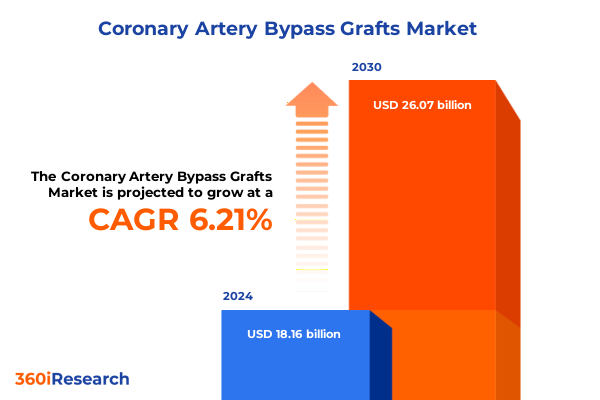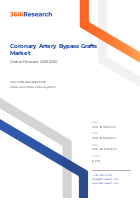The Coronary Artery Bypass Grafts Market size was estimated at USD 18.16 billion in 2024 and expected to reach USD 19.32 billion in 2025, at a CAGR 6.36% to reach USD 29.76 billion by 2032.

Exploring how emerging surgical approaches, technological advancements, and patient care priorities are redefining the coronary artery bypass graft landscape
Coronary artery bypass grafting remains a cornerstone intervention in the treatment of advanced coronary artery disease, addressing critical vessel blockages that jeopardize myocardial perfusion. As cardiovascular disease continues to rise globally, driven by aging populations and lifestyle factors, the volume and complexity of bypass procedures have grown in tandem, underscoring the ongoing importance of innovation in surgical techniques and graft materials. Moreover, evolving patient populations present new challenges in perioperative care, comorbidity management, and long-term patency outcomes, necessitating a comprehensive examination of both clinical and operational dynamics.
Against this backdrop, this executive summary distills current trends, transformative shifts, and critical market drivers shaping the CABG ecosystem. It highlights the strategic ramifications of recent trade policy measures, including the 2025 U.S. tariffs on key graft components and surgical instruments, as well as supply chain vulnerabilities in raw material sourcing and logistics networks. By synthesizing segmentation perspectives, regional dynamics, competitive landscapes, and actionable recommendations, this overview equips decision-makers with the intelligence needed to optimize surgical outcomes, streamline supply chains, and harness emerging technologies.
Uncovering the transformative shifts revolutionizing coronary artery bypass graft procedures from surgical innovation to patient-centric care
The coronary artery bypass graft field is undergoing a profound transformation driven by rapid surgical innovation, with minimally invasive techniques and off-pump approaches gaining traction in leading cardiac centers. Off-pump CABG procedures, which eliminate the need for a heart-lung machine, are being adopted to reduce perioperative risk and shorten recovery times, while endoscopic vessel harvesting and robotic-assisted platforms are enhancing precision and soft-tissue preservation. Complementing these procedural shifts, artificial intelligence–enabled imaging and intraoperative navigation tools are increasingly integrated into hybrid operating theaters, offering surgeons real-time guidance and predictive analytics to improve graft placement and patency outcomes.
Concurrently, the rise of ambulatory surgical centers hosting hybrid revascularization programs reflects a broader shift toward patient-centric care and cost containment. By combining minimally invasive LIMA-to-LAD grafting with percutaneous interventions in outpatient settings, providers are delivering high-quality outcomes with reduced hospital stays. This evolution is underpinned by evolving reimbursement models that reward efficiency and outcome-based care, encouraging the bundling of surgical instruments, graft materials, and imaging services into integrated offerings for hospitals, cardiac centers, and ambulatory facilities.
Examining the cumulative impact of 2025 United States tariff measures on the coronary artery bypass graft supply chain and cost structures
Early in 2025, the United States implemented a suite of tariffs targeting the importation of cardiac surgical instruments, graft materials, and related disposables, reshaping the cost structures across the CABG supply chain. Manufacturers heavily reliant on specialized conduits or robotic instrumentation components sourced from overseas markets have faced sudden escalations in landed costs, creating margin pressures and driving review of supplier contracts. This policy environment has heightened scrutiny of sourcing strategies and underscored the imperative for agile supply chain management.
In response to these trade-driven headwinds, device companies and healthcare providers are recalibrating procurement models by renegotiating supplier agreements, exploring alternative domestic manufacturing partnerships, and investing in regional production hubs. Smaller ambulatory centers, in particular, have been compelled to join centralized purchasing consortia to secure cost stability, while leading manufacturers are announcing U.S.-based production lines for critical components to mitigate future tariff risks and ensure uninterrupted graft availability.
Gleaning key segmentation insights that illuminate differential growth trajectories across graft types, procedural approaches, user settings, and clinical applications
Insights derived from segmentation analysis reveal that graft type selection is increasingly governed by long-term clinical outcomes, with arterial conduits commanding preference in patients requiring durable patency, while venous grafts remain essential in multi-vessel or complex presentations. Procedural modalities further differentiate market dynamics, as conventional on-pump surgeries continue to serve high-complexity cases, yet off-pump and minimally invasive approaches-encompassing endoscopic vessel harvesting and advanced robotic platforms-are capturing growing adoption in centers prioritizing reduced blood transfusion rates and expedited recovery protocols. Incorporating these surgical distinctions, end users span ambulatory surgical centers specializing in select minimally invasive procedures to tertiary hospitals and dedicated cardiac centers managing the full spectrum of bypass interventions.
Moreover, application-based analysis indicates that multi-vessel disease cases drive comprehensive graft utilization strategies, while single-vessel interventions support more targeted, less invasive modalities. This clinical segmentation informs resource allocation, capital investment in hybrid operating theaters, and strategic partnerships between device manufacturers and healthcare providers seeking to tailor graft offerings to distinct patient profiles.
This comprehensive research report categorizes the Coronary Artery Bypass Grafts market into clearly defined segments, providing a detailed analysis of emerging trends and precise revenue forecasts to support strategic decision-making.
- Graft Type
- Procedure Type
- End User
- Application
Delving into key regional insights that reveal divergent adoption patterns and strategic priorities across Americas, Europe Middle East & Africa, and Asia-Pacific markets
In the Americas, the U.S. market leads with advanced reimbursement frameworks and a robust device manufacturing base, supporting broad adoption of on-pump and off-pump procedures in both hospital and ambulatory settings. Integrated delivery networks are actively investing in hybrid operating theaters and robotic suites, while outpatient centers escalate minimally invasive CABG volumes to meet shifting payer incentives and patient preferences.
Across Europe, the Middle East, and Africa, heterogeneous healthcare funding models and health technology assessment requirements influence the uptake of innovative graft materials, with synthetic and tissue-engineered conduits gaining regulatory approvals at different paces. Reimbursement criteria remain a pivotal determinant for coverage of minimally invasive and robotic CABG procedures, prompting manufacturers to engage in outcome-based contracts and bundled procurement agreements to drive market access.
In Asia-Pacific, emerging economies such as China and India are expanding cardiac infrastructure to address a growing burden of coronary artery disease, supported by public health initiatives and rising medical tourism. Leading private hospital chains are collaborating with device innovators to introduce robotic and endoscopic CABG services, while governments enhance reimbursement schemes and cardiovascular screening programs to improve procedure volume and access to advanced grafting technologies.
This comprehensive research report examines key regions that drive the evolution of the Coronary Artery Bypass Grafts market, offering deep insights into regional trends, growth factors, and industry developments that are influencing market performance.
- Americas
- Europe, Middle East & Africa
- Asia-Pacific
Profiling key companies insights to spotlight strategic moves, R&D focus areas, and competitive positioning in the coronary bypass graft sector
Leading industry players are pursuing differentiated strategies to consolidate their positions in the CABG sector. Medtronic has intensified R&D around minimally invasive delivery systems and hybrid operating environments, coupling graft conduits with imaging and monitoring platforms to enhance intraoperative decision-making. Edwards Lifesciences is channeling investments into AI-driven procedural planning tools and next-generation anastomotic devices, aligning product roadmaps with emerging reimbursement codes for digital health integrations. Terumo Corporation remains focused on synthetic graft material innovations to improve biocompatibility and reduce restenosis risk, while forging alliances for scale-up of domestic production lines amid trade policy shifts.
Getinge AB is advancing automated vessel harvesting systems and expanding tissue-engineered graft partnerships-such as upcoming first-in-human trials by Humacyte-to address gaps in small-diameter graft availability and long-term patency outcomes. Meanwhile, Genesee Biomedical is leveraging proprietary biologic scaffolds and coatings to differentiate its graft portfolio, targeting centers of excellence that prioritize regenerative approaches and personalized surgical planning.
This comprehensive research report delivers an in-depth overview of the principal market players in the Coronary Artery Bypass Grafts market, evaluating their market share, strategic initiatives, and competitive positioning to illuminate the factors shaping the competitive landscape.
- Terumo Corporation
- Medtronic plc
- Getinge AB
- LivaNova PLC
- Edwards Lifesciences Corporation
- B. Braun Melsungen AG
- Baxter International Inc.
- Teleflex Incorporated
- CryoLife, Inc.
- ConMed Corporation
Driving actionable recommendations for industry leaders to strengthen resilience, foster innovation, and capture emerging opportunities in CABG care
Industry leaders are advised to fortify supply chain resilience by diversifying sourcing strategies, establishing regional manufacturing hubs, and developing flexible procurement frameworks that can withstand tariff fluctuations and raw material shortages. Proactively engaging with policymakers to shape favorable trade agreements and reimbursement policies will further mitigate cost pressures and support stable access to critical graft components.
Simultaneously, prioritizing investment in minimally invasive and robotic platforms, coupled with comprehensive surgeon training programs, will unlock procedural efficiencies and elevate patient outcomes. Collaborations between device manufacturers, healthcare systems, and digital health providers can accelerate the integration of AI-enabled planning tools and outcome-based contracting models, positioning organizations at the forefront of a value-driven CABG paradigm.
Outlining rigorous research methodology combining primary expert insights and comprehensive secondary analysis to ensure authoritative CABG market intelligence
This analysis is grounded in a rigorous research approach that blends primary qualitative insights from cardiothoracic surgeons, procurement specialists, and industry executives with quantitative secondary data from peer-reviewed journals, regulatory filings, and trade policy announcements. Expert interviews and advisory board consultations provided real-world perspectives on clinical adoption, supply chain challenges, and emerging technology impact.
Complementing primary research, a comprehensive review of secondary sources-including medical device registries, government reimbursement documents, and international trade publications-ensured a holistic understanding of regional market dynamics, tariff implications, and competitive strategies. This methodology underpins the credibility and reliability of the strategic intelligence presented herein.
This section provides a structured overview of the report, outlining key chapters and topics covered for easy reference in our Coronary Artery Bypass Grafts market comprehensive research report.
- Preface
- Research Methodology
- Executive Summary
- Market Overview
- Market Insights
- Cumulative Impact of United States Tariffs 2025
- Cumulative Impact of Artificial Intelligence 2025
- Coronary Artery Bypass Grafts Market, by Graft Type
- Coronary Artery Bypass Grafts Market, by Procedure Type
- Coronary Artery Bypass Grafts Market, by End User
- Coronary Artery Bypass Grafts Market, by Application
- Coronary Artery Bypass Grafts Market, by Region
- Coronary Artery Bypass Grafts Market, by Group
- Coronary Artery Bypass Grafts Market, by Country
- Competitive Landscape
- List of Figures [Total: 28]
- List of Tables [Total: 412 ]
Concluding synthesis highlighting strategic imperatives and future outlook for the coronary artery bypass graft field amidst evolving clinical and economic dynamics
The coronary artery bypass graft landscape is poised at the intersection of clinical innovation, supply chain realignment, and evolving economic incentives. Surgical advancements-ranging from off-pump and endoscopic techniques to AI-driven procedural planning-are reshaping treatment paradigms and patient pathways, while trade policy shifts and raw material constraints accentuate the need for supply chain agility.
As market players navigate segmentation nuances, regional disparities, and competitive dynamics, the strategic imperatives of resilient procurement, targeted R&D investment, and collaborative ecosystem engagement become paramount. Organizations that embrace these imperatives and align their portfolios with emerging clinical and economic trends will be best positioned to deliver superior patient outcomes and sustainable growth in the CABG domain.
Seize comprehensive CABG market intelligence and connect with Ketan Rohom to transform your strategic decision-making and growth trajectory
For tailored insights and immediate access to the full coronary artery bypass graft market research report, please reach out to Ketan Rohom, Associate Director, Sales & Marketing at 360iResearch. He will guide you through customization options, provide detailed sample content, and secure your comprehensive research package designed to address your strategic goals.

- How big is the Coronary Artery Bypass Grafts Market?
- What is the Coronary Artery Bypass Grafts Market growth?
- When do I get the report?
- In what format does this report get delivered to me?
- How long has 360iResearch been around?
- What if I have a question about your reports?
- Can I share this report with my team?
- Can I use your research in my presentation?




